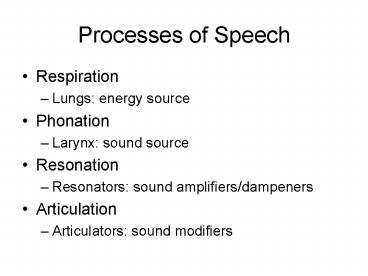Processes of Speech - PowerPoint PPT Presentation
1 / 17
Title:
Processes of Speech
Description:
Other manners of airflow. Obstruents. Produced with obstructed vocal tract ... Other manners (continued) Stridents. Produced by directing airflow against a surface ... – PowerPoint PPT presentation
Number of Views:213
Avg rating:3.0/5.0
Title: Processes of Speech
1
Processes of Speech
- Respiration
- Lungs energy source
- Phonation
- Larynx sound source
- Resonation
- Resonators sound amplifiers/dampeners
- Articulation
- Articulators sound modifiers
2
Main Processor
- Nervous system
- Central nervous system
- Brain
- Spinal cord
- Peripheral nervous system
- Nerves
3
Classifying Sounds of English
- Vowels and Consonants
- What makes a vowel a vowel?
- What makes a consonant a consonant?
4
Consonant Classification
- Placement of articulators
- Passive and active articulators
- Manner of air flow
- Where and how does air flow?
- Voiced or voiceless
- Are the vocal folds vibrating or not?
5
Placement of articulators
- Labials - lips
- Dentals - teeth
- Alveolars alveolar ridge
- Palatals hard palate
- Velars soft palate
- Glottals glottis
6
Manner of airflow
- Stops
- Fricatives
- Affricates
- Liquids
- Glides
- Nasals
7
Voiced vs. voiceless
- Voiced phonemes
- Vocal fold vibration
- All vowels are voiced
- Some English consonants are voiced
- Voiceless phonemes
- No vocal fold vibration
- Cognate pairs with voiced partners
8
Other manners of airflow
- Obstruents
- Produced with obstructed vocal tract
- Includes fricatives, affricates, and stops
- Sonorants
- Produced with relatively open vocal tract
- Includes liquids, glides and nasals
- Approximants
- Produced with relatively open oral tract
- Includes liquids and glides
9
Other manners (continued)
- Stridents
- Produced by directing airflow against a surface
- Creates considerable friction
- Includes /f, v, s, z, ?, ?, t?, d?/
- Sibilants
- Subset of stridents
- Hissing/hushing sounds
- Includes /s, z, ?, ?, t?, d?/
- Laterals
- Made with lateral airflow
- Includes the /l/
- http//www.uiowa.edu/acadtech/phonetics/about.htm
l
10
Website for consonant classification
- http//www.uiowa.edu/acadtech/phonetics/english/f
rameset.html
11
Vowel Classification
- Tongue position
- Tongue height in the oral cavity
- High mid low
- Tongue advancement
- Front central back
- Lip rounding
- Front vowels lip retraction
- Back vowels lip rounding
12
Vowel chart
Retracted lips --------------------Rounded lips
13
Distinctive Features
- A binary classification system indicating the
presence or absence of a feature - Can classify vowels or consonants
- Is it rounded or not rounded?
-
/w/
/l/
14
Chomsky Halle (1968)Distinctive Features
- Vocalic like a vowel
- Consonantal like a consonant
- High body of tongue elevated
15
Distinctive Features (continued)
- Back tongue elevates to velum
- Low tongue in lowest position /h/
- Anterior sound made with articulators at
alveolar ridge or forward - Coronal sound made with tongue blade raised
- Round lips rounded
16
Distinctive Features (continued)
- Tense degree of muscle tension
- Continuant flow of air not stopped
- Nasal sounds resonated in nasal
- cavity
17
Distinctive Features (continued)
- Strident forced airstream creates intense noise
quality to sounds - Sonorant unimpeded sound through oral cavity
- Interrupted completely blocked airflow at some
point in production - Lateral air flows along the lateral margins of
tongue - Voice vibrating vocal folds































